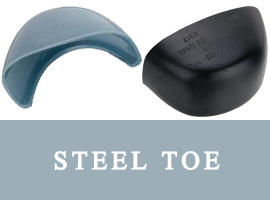Both composite and steel toed safety boots offer good protection for the toes against potentially dangerous impact and compression. Both types have their pros and cons, so there is no one right answer when looking for the best. Of course, the first thing to do is to ask your supervisor about the types of work boots to get, and depending on the actual job and potential risks for the toes, get the most appropriate pair for your job.

Composite toes
 Composite toed safety work boots have a safety toe protection which contains no metals and is made of carbon fiber, Kevlar, fiberglass or plastic.
Composite toed safety work boots have a safety toe protection which contains no metals and is made of carbon fiber, Kevlar, fiberglass or plastic.
This is very suitable for work places where passing through a metal detector is required. They are also much more comfortable on the toes than the steel cap ones, plus they are lighter, so overall, walking and wearing them is more comfortable.
Plus, for working in extremely hot or cold conditions, the composite cap protection will keep the feet more comfortable, since the composite materials do not conduct heat or cold as much as metal toe caps. Plastic also doesn’t conduct electricity, so if your job poses a risk of running into live wires, composite toe boots are a better idea.
Steel toes
 The steel toe work boots are the older, classic safety shoes which have been protecting the toes of a large number of workers for decades. Steel is tough, so it is not surprising that this type of shoes can resist to bigger impacts and more compression than those with composite caps.
The steel toe work boots are the older, classic safety shoes which have been protecting the toes of a large number of workers for decades. Steel is tough, so it is not surprising that this type of shoes can resist to bigger impacts and more compression than those with composite caps.
Overall, steel toed boots are still being worn not so much because of the bigger resistance to impact, but rather because they are cheaper than the work boots with composite toes. Steel toes also come in more different styles, which allows for a bigger choice in the safety shoe styling.
Composite toe vs Steel toe – full comparison
Steel toe boots
Composite toe boots
— Get your get the best composite toe work boot from our hand-picked collection
How to pick the right safety toes for you?
As we already mentioned, the question how to pick the best and most appropriate safety toed working footwear for you has no one right answer. It all depends on the type of work you do, the risks, work conditions, weather conditions, safety legal and company requirements, as well as your personal taste and preferences.
The more modern composite toe working boots are lighter and more comfortable than the steel toe shoes, but they tend to be more expensive than the metal ones.
Also, the comp toe shoes are rounder and more bulbous that the safety shoes with steel toes. The steel caps come in various shapes and forms, so the shoes don’t need to necessarily be rounded in shape. The reason why the composite toe shoes are more rounded is that more plastic, Kevlar, carbon fiber or fiberglass needs to be used in order to ensure they can adhere to the same ASTM standard tests which steel toe shoes can. The fact that steel is much stronger than the materials in composite caps makes it possible for less metal to be used, and thus for the shoes to be shaped more as normal and casual shoes, than the work boots with the composite toes.
Also, keep in mind, that even though the composite toe safety shoes can pass the initial compression and impact ASTM testing, every next impact or case of compression seems to weaken their resistance. This is the reason why it is recommended that you replace your composite toed safety shoes in case there is an incident in which something heavy falls or causes impact and compression. However, they are more expensive than the steel cap safety shoes, so replacing them often could be quite expensive.
If you reached the end of this comparison guide, you most probably know what you need, so why don’t you shop the best work boots for you now!





